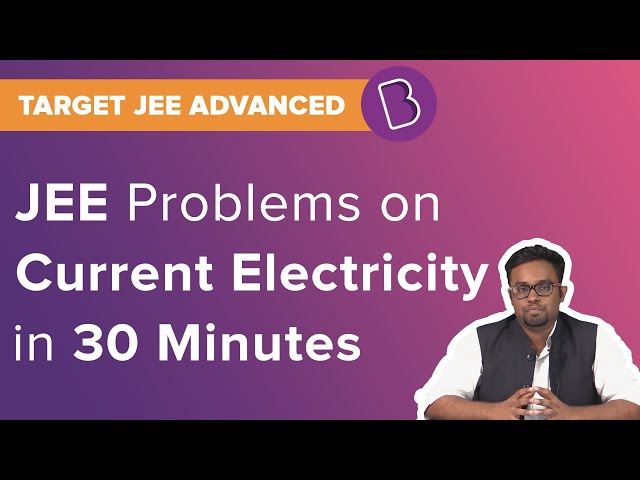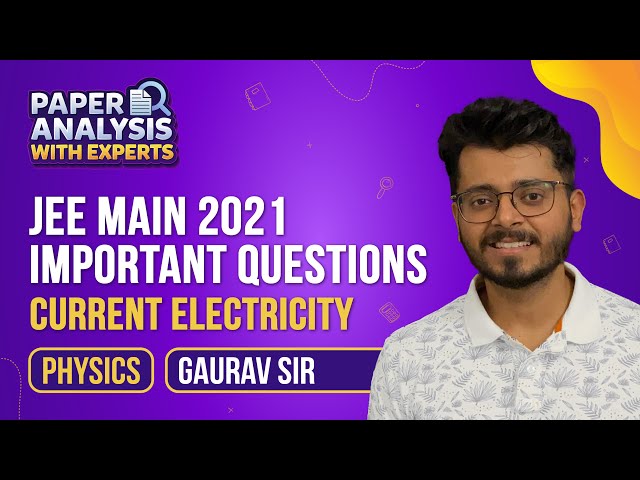Electricity is used to operate many electrical devices such as fan, refrigerator, bulb and many more. Electric energy can be changed to different forms of energy like heat, light or mechanical energy, in order to be useful. Electricity is produced by the movement of electrons through the wire. For the electric current to flow the circuit must be closed, in other words there must be an uninterrupted path from the power source through the circuit and then back to the source of power. The branch of physics that deals with charges in motion is termed as current electricity.
Any motion of charges from one section to another is current. When two bodies at different potentials are linked with a wire, free electrons stream from one body to the other body, until both the objects reach the same potential, after which the current stops flowing. Until a potential difference is present throughout a conductor, current runs. Difference in electric potential is called voltage and is measured in volts.
The force that opposes the flow of electric current is called resistance and is measured in ohms. The electric current lost due to resistance can be transformed to heat energy. The heat energy produced is used in an electric stove.
Download Current Electricity Previous Year Solved Questions PDF
JEE Main Previous Year Solved Questions on Current Electricity
Q1: Drift speed of electrons, when 1.5 A of current flows in a copper wire of cross-sectional area 5 mm2 is v. If the electron density of copper is 9 × 1028/m3 the value of v in mm/s is close to (Take charge of electron to be = 1.6 × 10–19 C)
(a) 3
(b) 0.2
(c) 2
(d) 0.02
Solution
As I = neAvd
vd = I/neA = 1.5/(9 x 1028 x 1.6 x 10-19 x 5 x 10-6)
v = 0.02 x 10-3 m/s = 0.02 mm/s
Answer: (d) 0.02
Q2: Two equal resistances when connected in series to a battery consume electric power of 60 W. If these resistances are now connected in parallel combination to the same battery, the electric power consumed will be
(a) 240 W
(b)120 W
(c) 60 W
(d) 30 W
Solution
The power consumed when two resistance are in series combination is
V2/2R = 60 W ⇒ V2/R=120 W
When the two resistance are connected in parallel combination, power consumed is
2V2/R = 120(2)= 240 W
Answer: (a) 240 W
Q3: A current of 2 mA was passed through an unknown resistor which dissipated a power of 4.4 W. Dissipated power when an ideal power supply of 11 V is connected across it is
(a) 11 × 10–4 W
(b) 11 × 10–5 W
(c) 11 × 105 W
(d) 11 × 10–3 W
Solution
Case (1)
As I2R = P
R = P/I2
R = (4.4)/(2 x 10-3)2= 1.1 x 106 Ω
Case (2)
P = V2/R = (11)2/(1.1 x 106) = 11 x 10-5 W
Answer: (b) 11 × 10–5 W
Q4: An ideal battery of 4 V and resistance R are connected in series in the primary circuit of a potentiometer of length 1 m and resistance 5Ω. The value of R, to give a potential difference of 5 mV across 10 cm of potentiometer wire is
(a) 490
(b) 495
(c) 395
(d) 480
Solution
Let I be the current in the circuit. 4 = (5 + R) I
I = 4/( 5 + R)——-(1)
For 1 m the resistance is 5 Ω
For 10 cm the resistance is
R10 cm = 5 x (10/100) = 0.5 Ω ——-(2)
Δv10 cm = I.R10 cm
According to given condition,
5 x 10-3 = [4/( 5 + R)] (0.5)
10-2 = [4/( 5 + R)]
(5 + R) 10-2 = 4
5 + R = 400
R = 395
Answer: (c) 395
Q5: A cell of internal resistance r drives current through an external resistance R. The power delivered by the cell to the external resistance will be maximum when
(a) R = 0.001 r
(b) R = r
(c) R = 2r
(d) R = 1000 r
Solution
The power delivered to resistance is I2R
i.e., P = [ε2/(R + r)2]R
For the maximum power,dP/dR= 0
⇒ -2R + (R +r) = 0 or R = r
Answer: (b) R = r
Q6: A metal wire of resistance 3 is elongated to make a uniform wire of double its previous length. This new wire is now bent and the ends joined to make a circle. If two points on this circle make an angle 60° at the centre, the equivalent resistance between these two points will be
(a) (7/2) Ω
(b) (5/2) Ω
(c) (12/5) Ω
(d) (5/3) Ω
Solution
R = 3 Ω
R = ρ(l/A) = ρ(l2/V)
R ∝ l2
R = 12 Ω (new resistance of wire)
R1 = 2 Ω
R2 = 10 Ω
Req = (10 x 2)/ (10 + 2) = 5/3 Ω
Answer: (d) (5/3) Ω
Q7: On interchanging the resistances, the balance point of a meter bridge shifts to the left by 10 cm. The resistance of the combination is 1 kΩ. How much was the resistance on the left slot before the interchange?
(a) 990
(b) 505
(c) 550
(d) 910
Solution
Let R1 (left slot) and R2 (right slot) be two resistances in two slots of a meter bridge. Initially l be the balancing length
Then, R1/R2 = l/(100 – l)———-(1)
R1 + R2 = 1000 Ω———-(2)
On interchanging the resistances, balancing length becomes (l – 10), so
( R2/R1)= (l – 10)/(110 – l)
Using (1)
(100 – l)/l = (l – 10)/(110 – l)
11000 + l2 – 210 l = l2 – 10l
200 l = 11000, l = 55 cm
From equa (1) R1/R2 = 55/45
Using (2)
R1 = (55/45)(1000 – R1)
R1 + (55/45)R1 = (1000)x(55/45)
100 R1 = 1000 x 55
R1 = 550 Ω
Answer: (c)550
Q8: A constant voltage is applied between two ends of a metallic wire. If the length is halved and the radius of the wire is doubled, the rate of heat developed in the wire will be
(a) Increased 8 times
(b) Unchanged
(c) Doubled
(d) Halved
Solution
Rate of heat developed, P = V2/R
For given V, P ∝ 1/R = A/ρl = πr2/ρl
Now, P1/P2 = (r12/r22)(l2/l1)
As per question, l2 = l1/2 and r2 = 2r1
P1/P2 = (¼) x (½) = ⅛
P2 = 8P1
Answer: (a) Increased 8 times
Q9: A heating element has a resistance of 100 Ω at room temperature. When it is connected to a supply of 220 V, a steady current of 2 A passes in it and the temperature is 500°C more than room temperature. What is the temperature coefficient of resistance of the heating element?
(a) 1×10– 4 °C–1
(b) 2 × 10– 4 °C–1
(c) 0.5 × 10– 4 °C–1
(d) 5 × 10– 4 °C–1
Solution
Resistance after temperature increases by 500°C,
RT = Voltage applied/Current = 220/2 = 110
Also, RT = R0 (1 + αΔT)
110 = 100 (1 + (α x 500))
α = 10/(100 x 500) = 2 x 10-4 0C-1
Answer: (b) 2 × 10– 4 °C–1
Q10: A uniform wire of length l and radius r has a resistance of 100 Ω. It is recast into a wire of radius r/2.The resistance of new wire will be
(a) 400 Ω
(b)100 Ω
(c) 200 Ω
(d)1600 Ω
Solution
Resistance of a wire of length l and radius r is given by
R = ρl/A = (ρl/A) x(A/A)
R = (ρV/A2) = (ρV/π2r4) (∵ V = Al)
i.e., R ∝ 1/r4
R1/R2 =(r2/r1)4
Here, R1 = 100 Ω , r1 = r, r2 = r/2
R2= R1(r1/r2)4 = 16R1 = 1600 Ω
Answer: (d) 1600 Ω
Q11: A 2 W carbon resistor is colour coded with green, black, red and brown, respectively. The maximum current which can be passed through this resistor is
(a) 20 mA
(b) 0.4 mA
(c) 100 mA
(d) 63 mA
Solution
The resistance of the resistor is 50 × 102 Ω . So, the maximum current that can be passed through it is
Answer: (a) 20 mA
Q12: In a large building, there are 15 bulbs of 40 W, 5 bulbs of 100 W, 5 fans of 80 W and 1 heater of 1 kW. The voltage of the electric mains is 220 V. The minimum capacity of the main fuse of the building will be
(a) 14 A
(b) 8 A
(c) 10 A
(d) 12 A
Solution
Power of 15 bulbs of 40 W = 15 × 40 = 600 W
Power of 5 bulbs of 100 W = 5 × 100 = 500 W
Power of 5 fan of 80 W = 5 × 80 = 400 W
Power of 1 heater of 1 kW = 1000
Total power, P = 600 + 500 + 400 + 1000 = 2500 W
When these combination of bulbs, fans and heater are connected to 220 V mains, current in the main fuse of building is given by
I= P/V = 2500/220 = 11.36 A ≈ 12 A
Answer: (d) 12 A
Q13: If a wire is stretched to make it 0.1% longer, its resistance will
(a) increase by 0.05%
(b) increase by 0.2%
(c) decrease by 0.2%
(d) decrease by 0.05%
Solution
Resistance of wire R = ρl/A……..(1)
On stretching, volume (V) remains constant.
So V = Al or A=V/l
Therefore, R = ρl2/V (Using (1))
Taking logarithm on both sides and differentiating we get,
ΔR/R = 2Δl/l (Since V and ρ are constants)
(ΔR/R)% = (2Δl/l)%
Hence, when the wire is stretched by 0.1% its resistance will increase by 0.2%
Answer: (b) increase by 0.2%
Q14: A thermocouple is made from two metals, antimony and bismuth. If one junction of the couple is kept hot and the other is kept cold then, an electric current will
(a) flow from antimony to bismuth at the cold junction
(b) flow from antimony to bismuth at the hot junction
(c) flow from bismuth to antimony at the cold junction
(d) not flow through the thermocouple.
Solution: Antimony-bismuth couple is ABC couple. It means that current flows from A to B at a cold junction
Answer: (a) flow from antimony to bismuth at the cold junction
Q15: The resistance of a wire is 5 ohm at 50°C and 6 ohm at 100°C. The resistance of the wire at 0°C will be
(a) 3 ohm
(b) 2 ohm
(c) 1 ohm
(d) 4 ohm
Solution
Rt = R0(1 + αt)
Rt is the resistance of wire at t0 C
R0 is the resistance of wire a 00 C
α is the temperature coefficient of resistance
R50 = R0 [1 + α(50)]
And R 100 = R0 [1+ α(100)]
Or R50 – R0= R0 α(50) ——-(1)
R 100 – R0 = R0 α(100) ——-(2)
Dividing (1) by (2)
(5 – R0)/((6 – R0) = ½
R0 = 4 ohm
Answer: (d) 4 ohm
Also Read:
Current Electricity JEE Advanced Previous Year Questions With Solutions
Current Electricity – JEE Main 2022 Important Topics

Current Electricity – JEE Solved Questions

Current Electricity Important JEE Main Questions

Current Electricity – Important and Previous Year Questions


Comments